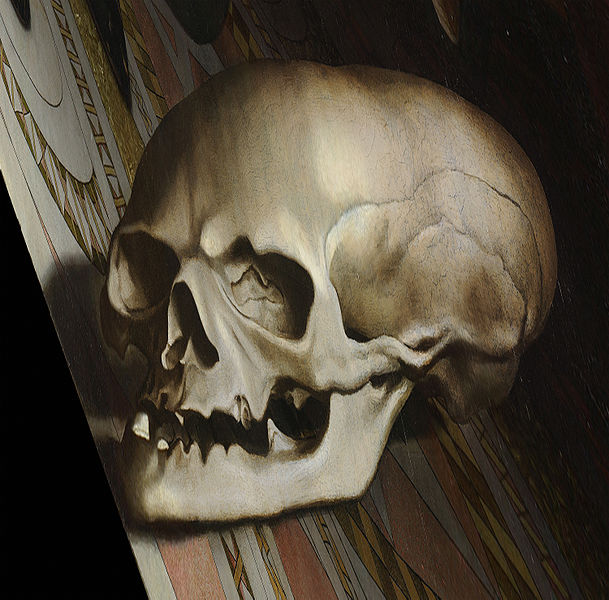The Ambassadors

Source: http://commons.wikimedia.org
Hans Holbein the Younger [Public domain], via Wikimedia Commons

Source: http://commons.wikimedia.org
A perspective manipulated image of the anamorphic skull which can only be seen when approaching the picture very closely from the right.
The Painting
The Ambassadors (1533) is a painting by Hans Holbein the Younger in the National Gallery, London. As well as being a double portrait, the painting contains a still life of several meticulously rendered objects, the meaning of which is the cause of much debate. It is also a much-cited example of anamorphosis in painting.
Although a German-born artist who spent most of his time in England, Holbein displayed the influence of Early Netherlandish painters in this work. This influence can be noted most outwardly in the use of oil paint, the use of which for panel paintings had been developed a century before in Early Netherlandish painting.
What is most "Flemish" of Holbein's use of oils is his use of the medium to render meticulous details that are mainly symbolic: as Jan van Eyck and the Master of Flemalle used extensive imagery to link their subjects to divinity, Holbein used symbols to link his figures to show the same things on the table.
The Artist
Hans Holbein the Younger (c. 1497 – between 7 October and 29 November 1543) was a German artist and printmaker who worked in a Northern Renaissance style. He is best known as one of the greatest portraitists of the 16th century. He is called "the Younger" to distinguish him from his father, Hans Holbein the Elder, an accomplished painter of the Late Gothic school.
Holbein's art was prized from early in his career. Holbein has also been described as a great "one-off" of art history, since he founded no school. Holbein's art has sometimes been called realist, since he drew and painted with a rare precision.
Holbein was never content, however, with outward appearance. He embedded layers of symbolism, allusion, and paradox in his art, to the lasting fascination of scholars. In the view of art historian Ellis Waterhouse, his portraiture "remains unsurpassed for sureness and economy of statement, penetration into character, and a combined richness and purity of style".